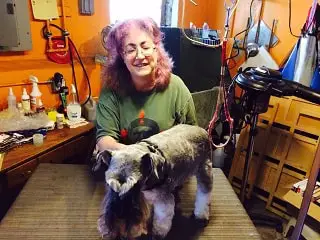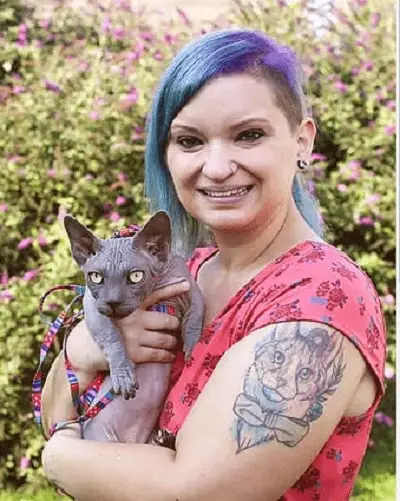Day in the life of
Dog Groomer – Robyn Michaels

My Typical Day
Every groomer manages their time differently & it also depends on your location, mix of breeds & whether you are an independent contractor, or if your ‘boss’ is a groomer or just a business person. We generally check in dogs when we open & this is to make sure every dog booked shows up. This is a service job, if clients ‘forget’ or don’t respect you, YOU lose money. If you have to rely on ‘walk-ins’ you never know how much money you’ll make.
Usually, the night before, we make sure we have towels & diluted shampoo ready but again, this depends on who manages the shop). It is more cost-efficient to prepare a dog for a bath (meaning, cutting off hair you know you’re getting rid of, demating, cleaning ears, cutting nails) & bathing the dog…then, while that dog is drying (we old-timers use evaporation as well as blowing air to force evaporation), prepping the next dog.
Depending on how much hair the dog has, how large it is, and how it behaves, we generally know how long a job task is going to take. On a humid day, or with a very large, hairy dog, job tasks will take longer—especially drying hair. It all depends on who made appointments, but to make money (especially if we are paid commission), the ‘average’ groomer will groom 4-12 dogs a day. Keep in mind, some of those will be ‘just baths’ & some will require more skill in scissoring, you have to learn how to manage your time.
Some groomers will take in 2-4 dogs at a time, every few hours, so the dog doesn’t have to sit in a crate for hours, some will groom 1 at a time. The groomer has to know how long the job tasks take. For a new client, we often have the dog come in for an ‘evaluation’ first.
A ‘typical’ day depends on your location and the economic base of your clientele. I’ve worked in shops in upscale neighborhoods where dogs came in once a week for a bath. In other locations, it was all we could do to get people to bring dogs in once or twice a year & often those dogs were very matted & had to be shaved, and owners balked at the price of grooming. These days with the internet (& everyone has a phone in their possession), there is no excuse for not learning the cost of grooming before getting the dog.
We find the breeders of designer mutts (Doodles, Bernadoodles, Shichon, Cavapoos) lie to buyers. People breeding mixes are breeding for a market they created they are usually less genetically sound than the breeds hobby breeders are breeding for the betterment of their breeds & this is important to know. Also, a hobby breeder will usually screen a puppy buyer more carefully and ask questions about how much time they have for a dog, and if they understand grooming & veterinary costs.
Pros and Cons
The industry has changed in the past 40 years. When I originally learned to groom, everyone involved in grooming & training was a fancier —that is, someone who had been mentored by others who really loved to learn about dogs and be with other fanciers. Everyone showed & trained dogs. These days, there are commercial dog grooming schools that are not very well regulated. Because you shave dogs for 60 hours—does that mean you can safely groom a dog & make it look good? If you want to learn to groom, it’s best to start with a dog breeder who shows dogs, and then research schools and find out who is doing the skill training, and how they learned to groom. They will teach you about the nuances of different breeds and how to make a dog look good (Google Champion Airedale Bengal Sabu—this dog is stunning).
You are doing physical labor and many groomers quit because they’ve injured their backs or wrists. You have to keep yourself in good physical condition. You can’t mind being wet and/or covered in hair. At the end of the day, you’ve had it—and for most groomers, after 6 hours, you tend to be less cautious, and mistakes happen—whether it be injuring a dog or cutting hair badly. You have to learn dog behavior and not be afraid to be in charge without injuring the dog. There are subtle things people who really love dogs know. You will often find dogs are spoiled and they bite, and their owners make excuses. Owners will argue about wanting their dogs to have long hair, but they won’t do maintenance brushing at home. You will have noisy dogs (& the dryers are also noisy machines—many groomers wear ear protection). Most shops offer no benefits; no health insurance, no paid vacation, no retirement plan. the shops that do offer benefits are often corporate owned & your immediate supervisor will NOT be a groomer, or be poorly trained, and will make you do things in a way that will take longer or be unsafe. You have to buy your own equipment—and it is a niche market. You will have to work most weekends—both days, so you will be limited to the number of dog shows you can go to & dog shows are where you learn to really groom by watching people prepping for their dog show class. Also, if you work for a non-groomer, they have no idea how to price service. Yes. it helps to know what others are charging, but your boss doesn’t care if you make a living wage. Some think $15/hr is fair. Do you want fries with that? Those who are paid a commission manage their time better because time is money. Being paid hourly, you have no incentive to manage your time well. Also, when the weather is bad—the last thing an owner thinks is having the dog groomed.
My very last job was at a boarding/training kennel, where the owner had actively shown and trained dogs. He was a field trial judge. The facility was safe and very well run. Unfortunately, the land was worth more than the business, and he had to sell it.
Advice to aspiring Dog Groomers
I would NOT suggest anyone becoming a dog groomer unless their vocation/hobby was training & showing dogs & they have the capital to buy a boarding kennel. Even then—the economy has changed so much just since the Bush II years. Really. The last kennel I worked for was an exceptional business in an upscale community & COVID was the final nail in the coffin. In spite of what PIJAC says, this is not a growth industry. Considering grooming is skilled labor, pay & benefits are barely adequate. You can Google “How much does the average dog groomer make.” I averaged about $35,000 a year due to unfair work/pay models, the economy & seasonality. On 1 job, I did get health insurance, but no paid vacation. (In fact, on 1 job, I increased grooming net by over 10%—but they cut my health insurance because I wasn’t working an ‘average’ of 30 hours a week. They penalized me for managing my time well. No joke.
To be a groomer, you have to be a visual artist. You have to be able to look at the dog not just as an animal, but as a 3-D piece of art whom you can enhance. Many times, I have said, “Less is more. I can’t make this dog look any better than he already looks.” Seriously. And non-grooming bosses have been mad that I’ve told people that. Just because your only tool is a hammer, doesn’t mean everything is a nail. Similarly, just because you have scissors & clippers, doesn’t mean they all need haircuts.
If I haven’t dissuaded you, find a professional handler who shows coated dogs. Join a local dog club. You can contact the AKC to find out about local clubs, but call area animal hospitals & groomers and ask if any of their clients show dogs. I am a member of Northshore Dog Training Club—one of the oldest nonprofit dog training clubs in the USA, and several of our members are breeders or liaise with breeders. You can explore dog grooming schools, but they are expensive, and if the people running the school & teaching ARE NOT FANCIERS, you will not learn the nuances of breeds. It’s best to learn 1 AKC breed standard for a groomable breed, and have others mentor you in understanding the standard, then learn the other breeds.
Fact is, now that people think designer dogs (Doodles, Cavapoos, Shichon) are breeds—which do not breed ‘true’, we are going to lose breeds: Bedlington & Lakeland Terriers, Miniature Schnauzers, Standard Schnauzers, Dandie Dinmonts…to lack of gene pools. Breed matters. It will get to the point where only very wealthy will be able to buy rare purebreds, and those who ‘just wanted a pet’ won’t find genetically sound dogs, or be able to choose size or coat type.
Dog Groomers
Dog Groomers wash and cut dog hair, trim nails, and occasionally brush dogs’ teeth. They often give dogs specific hairstyles based on the instructions of the dog owner.






.jpg)